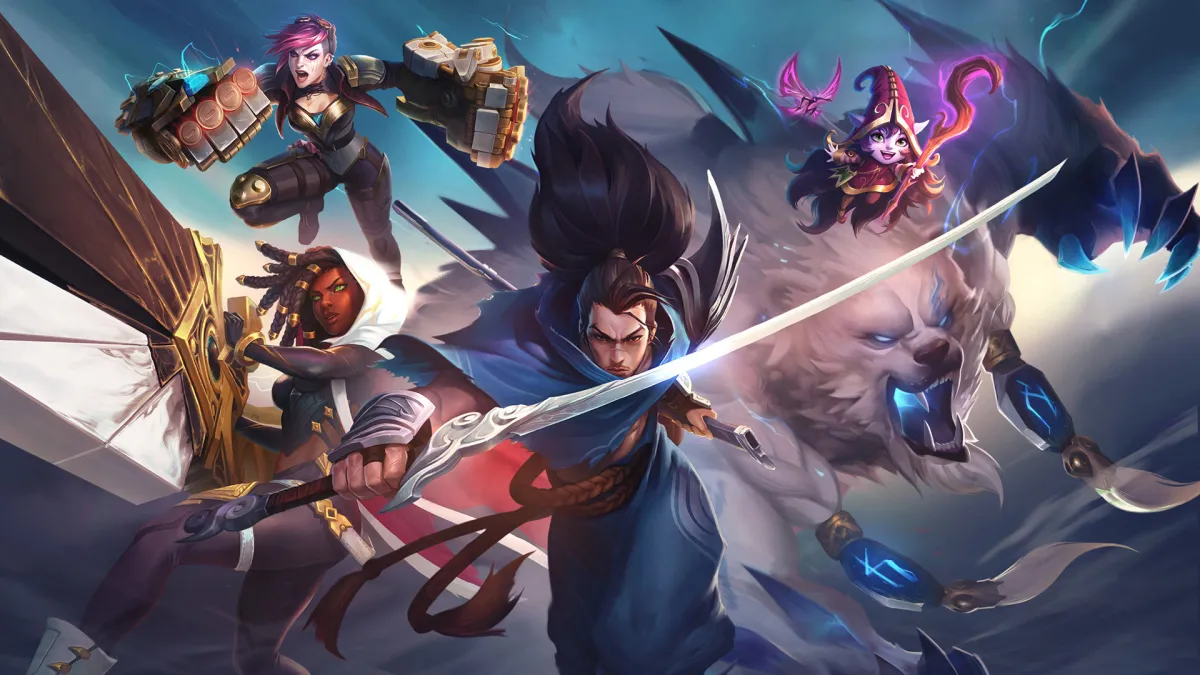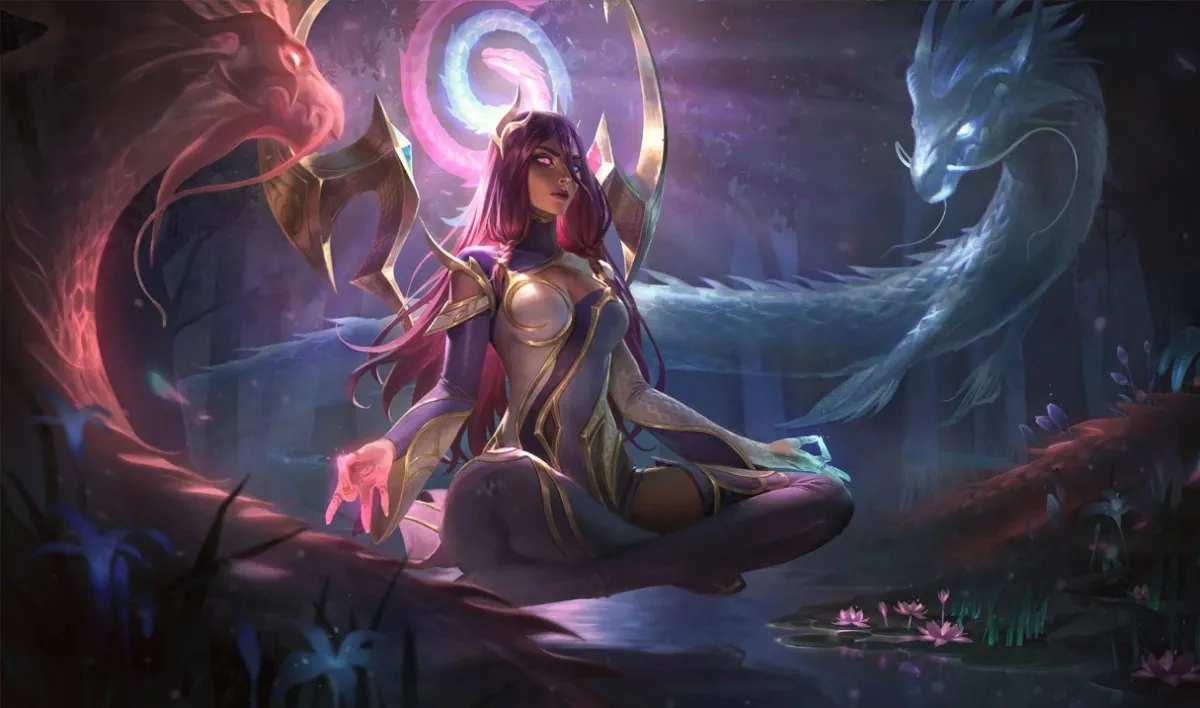Controlling buffs is one of the keys to victory in League of Legends. Buffs provide a tangible benefits to the champion who wields them, and often are the difference in a close fight, deciding which mid laner has enough mana to cast a last spell, or marksman has the bonus damage to finish off a close kill.
A buff is a timed effect that boosts the statistics of a character, providing a tangible combat benefit for a short period of time. In League of Legends, the two most commons buffs are the Crest of the Elder Lizard, or “Red Buff”, and the Crest of the Ancient Golem, or “Blue Buff”. Both are named for the jungle monster that provides the effect when killed, but colloquially titled after their colored visual effects.
The Red Buff adds extra damage to a champion’s basic attacks, as well as a slow effect, making it ideal for marksmen and brawling champions. But the Blue Buff is much more important, a staple of mid lane matchups.
The Blue Buff provides mana regeneration and cooldown reduction, turning a champion into a spell slinging machine. The statistics a Blue Buff provides are worth an estimated 2000 gold for its two-and-a-half minute duration. That’s the size of a pretty hefty item.
We took a look at how well teams controlled their buffs, and especially the blue buff, in the League Championship Series so far this season. Which teams are the best at controlling their buffs? How do they distribute the buffs? Do most teams do it the same, or are there outliers?
Our sample size was the first half of the season, the 14 games before the currently running Super Week.
We looked at buffs in the context of the map as a whole, instead of just say buffs from a team’s own jungle. “Buff Control” signifies what percent of the total available Red and Blue buffs a team acquired over the course of the match, so it measures both how well a team controls their own buff and how well a team controls the enemy’s. That shows what priority a team places on the buff, and how successful they are securing them.
The team that performed best at controlling buffs through the previous week of LCS was Team SoloMid, who acquired 54.89 percent of all buffs on the map. They were followed closely by Europe’s Fnatic, who controlled 54.44 percent of buffs.
You might expect the teams with the best records would benefit from the best buff control—for one, they’re doing well, so they likely took advantage of having more buffs, and two, winning games necessarily means they have more map control, so they are able to rack up more buffs late in the game while they are controlling map.
But the stats show that isn’t always the case. SoloMid, for example, isn’t ranked in the top three of their league, and in our sample, neither was the then 7-7 Fnatic.
There are other outliers, too. Millenium had a solid 8-6 record through fourteen games, but they posted the lowest buff control of any team in the league at 45.26 percent. Their objective control stats are very strong, rankings second in the EU LCS, so they may be trading buffs to take dragons and towers.
So that means the numbers have some value in differentiating team play styles, and possibly figuring out which ones lead to victory. To find out more, we looked at Blue Buff control specifically, and how each team distributed the buffs they controlled.
Some important numbers for contextualizing the stats: the EU LCS averaged 13.51 blue buffs per game, while the NA LCS put up 11.875 blue buffs per game. The difference largely comes down to game time: European games are 40:48 long, while America averages 36:28.
Like the overall buff control statistic, Blue Buff Control was scaled to all blue buffs on the map, as were the individual role totals. For example, the numbers indicate that the mid laner for SK Gaming, Jesse “Jesiz” Lee, received 35.63 percent of the blue buffs in games he played, compared to 15.52 percent for his jungler and 54.02 percent for his team overall.
The European region is known for its star mid laners, so it’s no surprise that some of those icons lead the charts.
Fnatic takes the Blue Buff 54.05 percent of the time, and Enrique “xPeke” Cedeño Martínez himself receives it at a 37.30 percent rate in his games.
Alliance wins many a Blue Buff, fourth in the EU LCS with a 52.51 percent control mark, and mid laner Henrik “Froggen” Hansen takes 34.08 percent of the overall blues. But that number is a little skewed – Hansen has a game on Yasuo, a mana-less mid laner that gets little use from his own blue. No LCS mid laner has taken a blue buff while playing Yasuo this season. In games on mana-based champions, Alliance takes blue for Hansen 36.7 percent of the time, more in line with their team number.
The big surprise in Europe thus far is ROCCAT. The surging team only controls 51.69 percent of buffs, but posted a whopping 56.35 percent blue control stat. Their mid laner, Remigiusz “Overpow” Pusch, is taking blue 39.23 percent of the time. Pusch has received more blue buffs than any other mid laner this season, 71, and his team is taking them at a higher rate.
ROCCAT’s jungler Marcin “Jankos” Jankowski also takes an above average number of blues: 14.92 percent. It seems ROCCAT is forsaking red buffs in favor of prioritizing blues, a strategy that may seem to indicate them pushing Pusch as their carry player.
Copenhagen Wolves is another interesting case. Unsurprisingly, the subpar team posted poor buff control at 46.32 percent, but their distribution was different compared to every other team in the league. On average, mid laners took about 2.2 times as many blue buffs as their jungling teammates.
But Wolves was the only team in the league whose jungler took more buffs than their mid laner—and it wasn’t even close. Karim “Airwaks” Benghalia grabs 23.95 percent of blue buffs in his games, a full 7 percent higher than the next ranked jungler, Curse Gaming’s Christian “IWillDominate” Rivera.
Part of the reason is champion selection. Wolves mid laner Viktor “cowTard” Stymne played three games on Yasuo to start the season, freeing up the blue buff for his jungler. But in games excluding Yasuo, the team still only managed to give the blue to Stymne in 23.26 percent of opportunities, while Benghalia showed 16.27 percent control, a ratio favoring the jungler much more than any other team in the league.
Is that a conscious strategy on the part of Wolves, trying to feed their jungler, or does Stymne just miss buff timings? Maybe Benghalia does a similar job to other junglers of taking blues in invades, but Wolves fails to protect their own buff for Stymne’s benefit.
The NA LCS follows a similar pattern: The teams with star mid laners prioritize the Blue Buff. But much like the standings, the buff control stats are a lot more even.
While Team SoloMid has a 3 percentage point lead on buff control over other teams in the league, the other four contenders all posted numbers between 50.70 percent and 51.71 percent. Their distributions, however, were quite different.
LMQ and Dignitas are known for their star mid laners, Yu “XiaoWeiXiao” Xian and Danny “Shiphtur” Le. As such, it’s no surprise they focused on giving blue buff to their power players. Xian took blue 35 percent of the time in his 11 games on champions other than Yasuo, while Le managed it in 36.31 percent of cases. Those were the top two numbers in the region. But both teams are sacrificing red buffs to boost their mid laners: Their blue buff control numbers were both three percentage points above their total buff control numbers.
Counter Logic Gaming, on the other hand, handles things quite differently. They control 50.96 percent of all buffs, which is just 0.26 percent higher than LMQ’s number. But Counter Logic Gaming only controls 46.84 percent of blue buffs. That’s a whopping 8 percent less than LMQ’s 54.49 percent number.
So that means Counter Logic Gaming focuses their efforts on the red buff, which makes sense considering their star player is the marksman Peter “DoubleLift” Peng, and marksman benefit most from the auto-attack boosting red.
Much like Copenhagen Wolves in Europe, Curse Gaming’s blue buff numbers are skewed thanks to their mid laner Voyboy’s reliance on Yasuo. In games where Curse doesn’t use that champion, they’re taking blue for mid 30.51 percent of the time, a much more reasonable amount for a team with their admittedly poor 43.43 percent overall buff control.
Other interesting things to note: Teams take advantage of mid lane Yasuo in different ways. For example, last week LMQ used him against Team SoloMid, paired with a top lane Lulu. That allowed Lulu to pick up 8 out of 18 blue buffs, which boosted LMQ’s distribution for the “other” category to 8.99 percent.
Other outliers include Team SoloMid, who gave their blue buff over to Jason “WildTurtle” Tran on Corki during a match against Evil Geniuses where their mid laner Soren “Bjersen” Bjerg played Yasuo. It seems that one advantage of Yasuo, if not his imposing presence as a capable carry, is the ability to distribute your buff resources differently, if your team builds a composition to take advantage of it.
These are just basic stats regarding the blue buff, and how teams are distributing it this season. It’s the tip of the iceberg in what could be a wide field of study.
There’s plenty of room for further research, like looking at how effective controlling buffs really is, like how ROCCAT’s mid taking more buffs helps him in game, or Wolves’ mid taking less hurts.
Studying where the buffs are coming from and how teams secure them might also have value. Are they making sure they get all of their own buffs, or often invading the enemy jungle? Are the blue buffs taken by junglers, roughly 28.14 percent of them overall, mostly from invades?
The red buff, which adds a slow and extra true damage to auto attacks, is another area that deserves further study. While it doesn’t receive as much attention as the huge boost the blue buff affords mid laners, the red buff often decides fights.
We’ve already seen how a team playing Yasuo frees up the blue buff for other laners. What kind of boost does that provide? What other champions benefit? In the future, it will be useful to look at buff control and distribution based off team composition could be useful.





